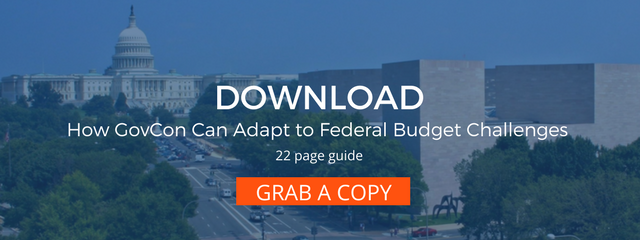On May 23, 2017, the White House Administration released to the public part two of its FY18 budget named “A New Foundation for American Greatness.”
This document works in tandem with the FY18 “skinny budget” called “America First: A Budget Blueprint to Make America Great Again” released in March 2017.
In summary, the FY18 “Foundation” Budget proposes to slash non-defense discretionary spending (NDDs) spending by $3.6T over the next 10 years and increases the defense spending $52B (~3% up from FY16) [1].
Without one concise budget document, and with White House and Congressional policies and priorities changing in real-time with every tweet, and with “breaking news” breaking every 5 minutes – it is time that we turn our focus back to the items that have a direct impact on us, the GovCon industry.
While a reprioritized budget, calls for Federal reorganization, and Federal workforce reduction are not earth-shattering concepts during a new Administration's transition into office, there are more factors at play today than in the past.
More than ever before, the Federal workforce is being worn down and planned programs and projects are being canceled as funding is bottlenecked and leadership positions are left vacant.
It is critical that all of us in the GovCon community (all 170,000+ Government Contracting organizations) pay close attention to the impact this is having on the stakeholders that make our Government Contracting world go around.
In this article using budget data I will be exploring:
- Challenges: An honest look at some of the challenges we are facing.
- Strategy Adjustment: How we as members of the GovCon community should begin to adjust our strategy to pursue meaningful programs and projects with intent.
- Productive Transformation: How we can create productive change to assist our Federal counterparts in truly transforming the Federal and State and Local marketplace, regardless of Administration changes.
Change Orders Effecting the Federal Workforce and GovCon Foundation:
Everything is on the table and the current impacts of the factors mentioned above are TBD. In an industry where your strategy to scale and your growth lives and dies with Federal agency direction and mission, productive and driven CO’s, and a timely budget – uncertainty is not good. Let's take a look at the change orders.
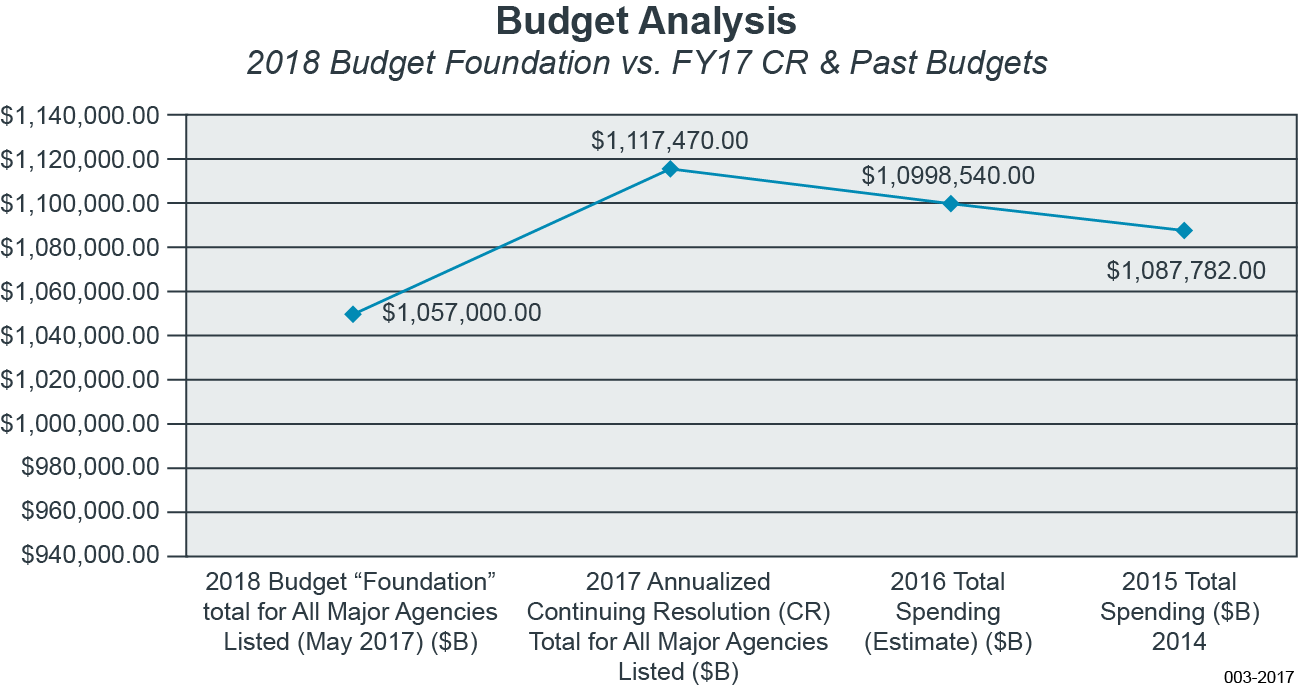
Exhibit 1
The most recent being the FY18 “Foundation” Budget, where the Administration lays out their goal to reprioritize and control Federal spending and streamline the Government by:
- Reforming (and reducing) Federal employee retirement benefits that “will not impact the Federal Government’s recruiting and retention efforts” (pg. 11 of FY18 “Foundation” Budget)
- Reducing the Federal Government to redefine its proper role and promote efficiency (pg. 12 of FY18 “Foundation” Budget)
- Reducing the Federal Government by reducing non-defense discretionary spending each year by 2%, for each non-defense agency, until 2027 (pg. 13 of FY18 “Foundation” Budget)
- Implementing a comprehensive plan to reform the Federal Government and reduce the Federal administrative workforce by encouraging agencies to find greatest efficiencies from “insourcing, reducing management lawyers, reviewing programs, shared services, outsourcing or restructuring” (pg. 14 of FY18 “Foundation” Budget)
Factors such as being further stretched for resources, changing missions and unclear goals, lacking the required levels of leadership, and moving targets and changes in priorities and objectives. This all while being tasked to evaluate, cancel, eliminate, and end programs and projects that they believe in – and doing “more with less” while working hard to get solicitations out the door.
.png?width=883&height=737&name=002-2017%20(2).png)
Exhibit 2
With all of this going on, how long can the GovCon community expect our Federal program partners and acquisition/procurement counterparts to put out meaningful RFP’s with actual intent and funding behind them, at a consistent pace and approach that is required for our organization’s growth?
The reality is with these factors at play, and the Federal procurement system needing an extreme makeover, we cannot expect it for much longer.
The GovCon industry is caught in an agile sprint cycle rather than a consistent state of work.
This has been caused by factors such as changing acquisition trends (GWACS or individual solicitations anyone?) and increased Government spending and awards over the past few years (Exhibit 1). As a GovCon organization, you signed up for this life, but this has been increasingly concerning as Federal agencies are forced to change and adapt their direction in real time with the ever-revolving door of objectives and concerns.
Evidence of the widening gap between the Federal’s undecided priorities can be seen when examining the measureable differences between the FY17 Continuing Resolution (CR), FY18 “Blueprint” Budget, and FY18 “Foundation” Budget as shown in Exhibit 2. This is propagated when you compare Exhibit 2 to FY14 – FY16 total spending as shown in Exhibit 1. If the numbers do not impress you, you can compare my notes on what is actually detailed in these three documents (FY17 CR, FY18 “Foundation” Budget) at the end of this article in the Summary Chart to see the inconsistencies.
As the GovCon marketplace rapidly evolves, these key issues and impacts are being felt across the industry and further widening the gap.
Programs and solicitations are being “pushed right,” or continue to be extended for over a year (example, Veterans Affairs Community Care Network RFP), or cancelled in their entirety prior, during, or after the proposal phase. This bait and switch has been on the rise over the past 3 months and is equally frustrating to GovCon and the Federal workforce as it wastes time, limited resources, and money. Examples include:
June 2017 - Cancellations:
- Library of Congress Development of a Risk Management Framework due to the Contracting Office deciding to bring the solution in-house
- VA’s AEC Construction Services to Construct Cancer Treatment Center at the Overton Brooks VAMC due to incomplete funding
- Department of Justice (DOJ) Federal Bureau of Prisons (BOP) Vocational Building Trades Program for FCI Sandstone due to lack of funding for vocational training programs
- Department of Air Force Air National Guard (ANG) National Guard Readiness Center Civil Engineering IDIQ (ANGRC NGB/A7X) due to lack of funding
- Department of Education Federal Student Aid (FSA) Customer Support and Contract Center Non-Loan Servicing contract due to shifting priorities
May 2017 – Cancellations:
- U.S. Agency for International Development (USAID) Overseas Mission in Afghanistan for Logistical Support and Services due to the strategic shift in the mission’s requirements
- Department of Homeland Security (DHS) Flexible Agile Support for the Homeland (FLASH) IDIQ due to missteps and problems that occurred during the acquisition process
- Department of Transportation (DOT) Support for FMCSA Strategic Planning and Program Verification and Validation was canceled after proposals were submitted for reasons undisclosed
- Department of Veterans Affairs (VA) RFP for 2 digital centers in support of the Veteran-focused Integration Process (VIP) just five days into the solicitation due to VA’s changing modernization priorities
- Air Force Commercial Training Blanket Purchase Agreement (BPA) due to the DoD-wide strategic sourcing push to save costs by eliminating redundant contract vehicles for the same requirement
- Army Corps of Engineers (USACE) AEC Design Build of Hammerhead Barracks at Fort Hood Texas because the contracting office stated “this project is not happening in the foreseeable future”
- Department of Homeland Security (DHS) Contract in Support of the Port of San Ysidro cancelled this effort and “it is not clear at this time if this will be a future requirement”
April 2017 – Cancellations:
- Defense Information Systems Agency (DISA) Agency Program Support (APS) canceled mid-RFP due to the agency’s need to revise its acquisition strategy to ensure that it bests aligns with Federal category management activities
- Army Medical Command (MEDCOM) requirement for Clinical Social Worker at Womack Army Medical Center (WAMC) at Ft. Bragg due to change in mission
- Department of State (DOS) Counter Threat Security Training requirement because the majority of the Program Office POC’s that were involved in the market research no longer work at DOS therefore it will not result in an acquisition effort
- Department of State (DOS) Safety Compliance Services for Global Aviation Services due to a funding situation
- Navy Supply Systems Command for Program Analyst Training Services due to the Government no longer requiring these services
At-Risk Construction and Preparing for Impact:
To appreciate the possible implications, we need to assess the FY18 “Foundation” Budget in conjunction with the Administration’s tax proposal. The Administration’s aggressive tax proposal is likely cutting taxes on wealthy earners and large corporations thus causing the Federal Government a major loss in tax revenue leaving an unbalanced budget.
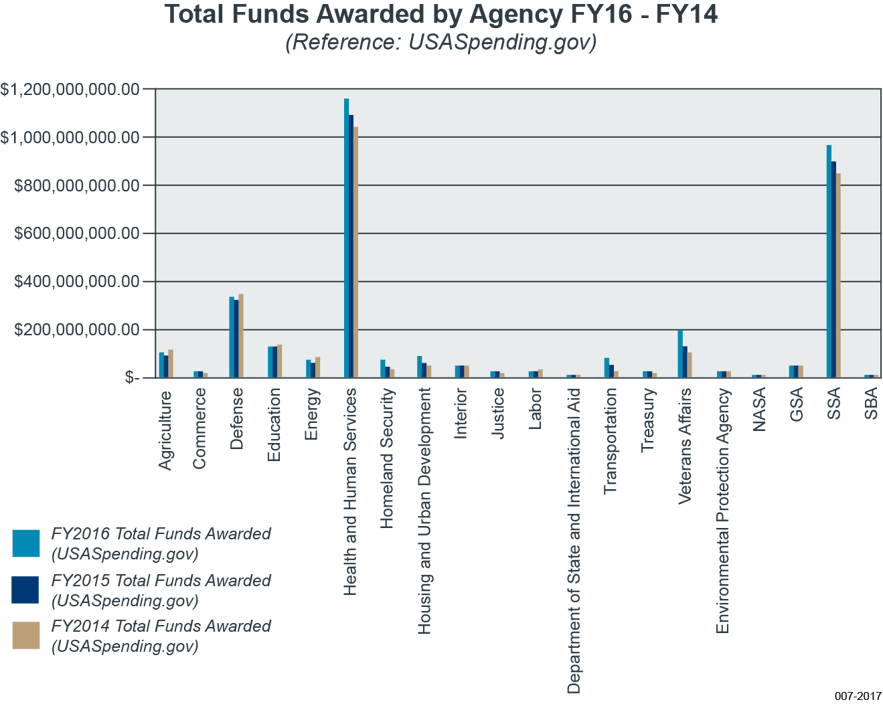
Exhibit 3
The loss in revenue for the Federal Government from these tax cuts will need to be balanced out by cuts in Federal spending and funding, thus impacting GovCon because there will be fewer opportunities to work with the Government in the future. In other words less money, less contracts. With funding cut across the board for NDDs, agencies will have fewer contracting dollars to give towards your organization for new awards as well as potentially funding awarded contracts that you are executing on now.
Simply put, the potential for impact is great. The Federal Government would be smaller, more opportunities will be pushed to State and Local Governments, and there will be less money for GovCon contracts.
.png?width=883&height=390&name=006-2017%20(2).png)
Exhibit 4
Funding for NDDs is on the chopping block in the FY18 “Foundation” Budget, and will be for the next 10 years if the budget is passed as is. This wholesale triage of a vast array of Federal activities will have consequences and will potentially influence already awarded funds, which have increased significantly from FY14 to FY16 as shown in Exhibit 3 and Exhibit 4. Multiple programs across NDDs would be eliminated in their entirety or vastly downsized, thus canceling or terminating contracts that have already been awarded to GovCon organizations. This is of course, unless you are doing work in the national security and defense sector.
Re-Calibrating Your Value Analysis and A Call to Action:
With hot button headlines and priorities and policies playing out in real-time (sometimes in 240 characters or less) the GovCon industry must constantly update their memory bank and knowledge of the political agenda as well as the Federal landscape. This is critical to not only opportunity identification, capture, and strategic growth plans – but is also key to successfully executing on current programs.
The GovCon industry will need to responsibly assist our local and Federal counterparts in generating ideas and developing innovative yet realistic solutions to the problems they face. We are able do this through the use of various methodologies and tools such as intentional bidding, unsolicited white papers, and building improved relationships between industry and State, Local and Federal Government.
Federal Government Partnerships
- Work more closely with your Federal agency counterparts to ensure that they have a “strong pulse” of the Government’s need.
- Build new relationships with the Federal stakeholders where you can be certain to see leadership, direction, and funding such as: DOL, DHS, DoD.
- Research and communicate with Regulatory Reform Officers and Regulator Reform Task Forces in each agency to gain insight on their mission and path in order to keep current on the environment within the agency.
- Invest in more “thought leadership” and the creation of white papers and unsolicited proposals. This will assist your Federal partners in developing ideas and solutions that are currently being asked of them. Likewise, offer insight on issues that have yet to be identified, to solve problems they might not know they have. Examples include:
- Assisting in reforming the disability programs where the Administration identifies a need to improve program integrity, close loopholes that make the program more susceptible to fraud and address inequities in the system (pg. 10 of the FY18 “Foundation” Budget).
- Providing white papers and unsolicited proposals that will assist DOS / USAID in their search for new, innovative internal training (pg. 13 of the FY18 “Foundation” Budget).
- Providing realistic and innovation solutions for better capturing the impact of immigration policy decisions on the Federal Government’s fiscal path (pg. 16 of the FY18 “Foundation” Budget).
State & Local Partnerships
- Cultivate relationships with State and Local Governments stakeholders to gain insights into potential opportunities and areas of innovation.
- Explore opportunities to bring innovation to your local community in regards to infrastructure since the responsibility will most likely flow down to them and not Department of Transportation (DOT).
- Assist State and Local stakeholders on bettering the programs that will be increasingly flowed down to them such as the Child Support Programs and Child Support Technology Fund (pg. 10 of FY18 “Foundation” Budget).
The Critical Path Forward:
A path of undecided priorities is evidenced further by the House Republican’s push to move forward with an omnibus bill to fund all Federal agencies for FY18 rather than go through “regular order” of 12 distinct funding bills. However, both House and Senate panels have just started holding appropriations hearings this week and are well behind schedule, which not only puts an omnibus bill dream out of reach, but also risks the achievement of annual spending bills by September.
It is important to keep in mind that the annual budget proposal is just a proposal. Congress has the ultimate say in funding and priority decisions, which may or may not be different than the budget proposal as is evidenced by the difference in FY17 CR and the FY18 “Blueprint” and “Foundation” Budget shown in Exhibit 2 and the Summary Chart below.
Now It's Your Turn:
Thank you for reading this analysis. I encourage you to please share in the comments below if and how your organizations have been impacted by shifting federal priorities and cuts recently.
Summary Chart: Broad Agency Breakdown Based on FY18 "Foundations" Budget
The Summary Chart below summarizes the FY18 “Foundation” and the FY17 CR Focus Areas in order to demonstrate the differences in priorities. To take this a step further, you can also compare this summary table to the previous summary table created when the FY18 “Blueprint” Budget was released back in March.

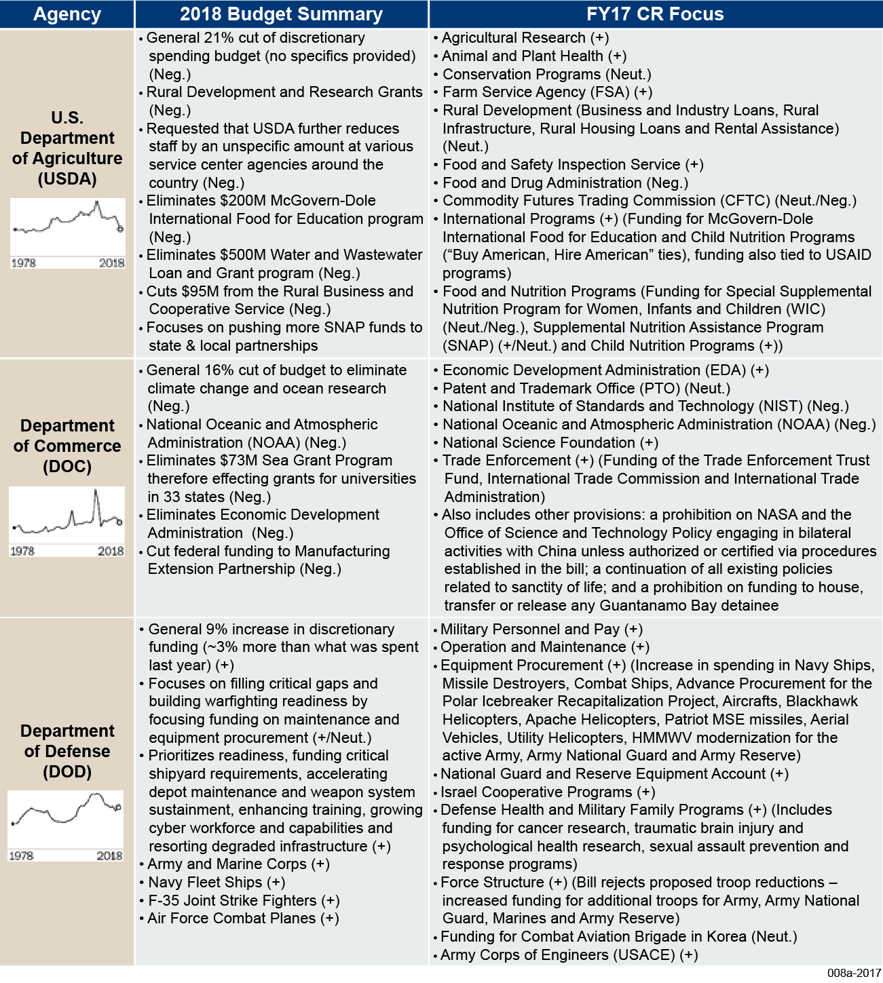
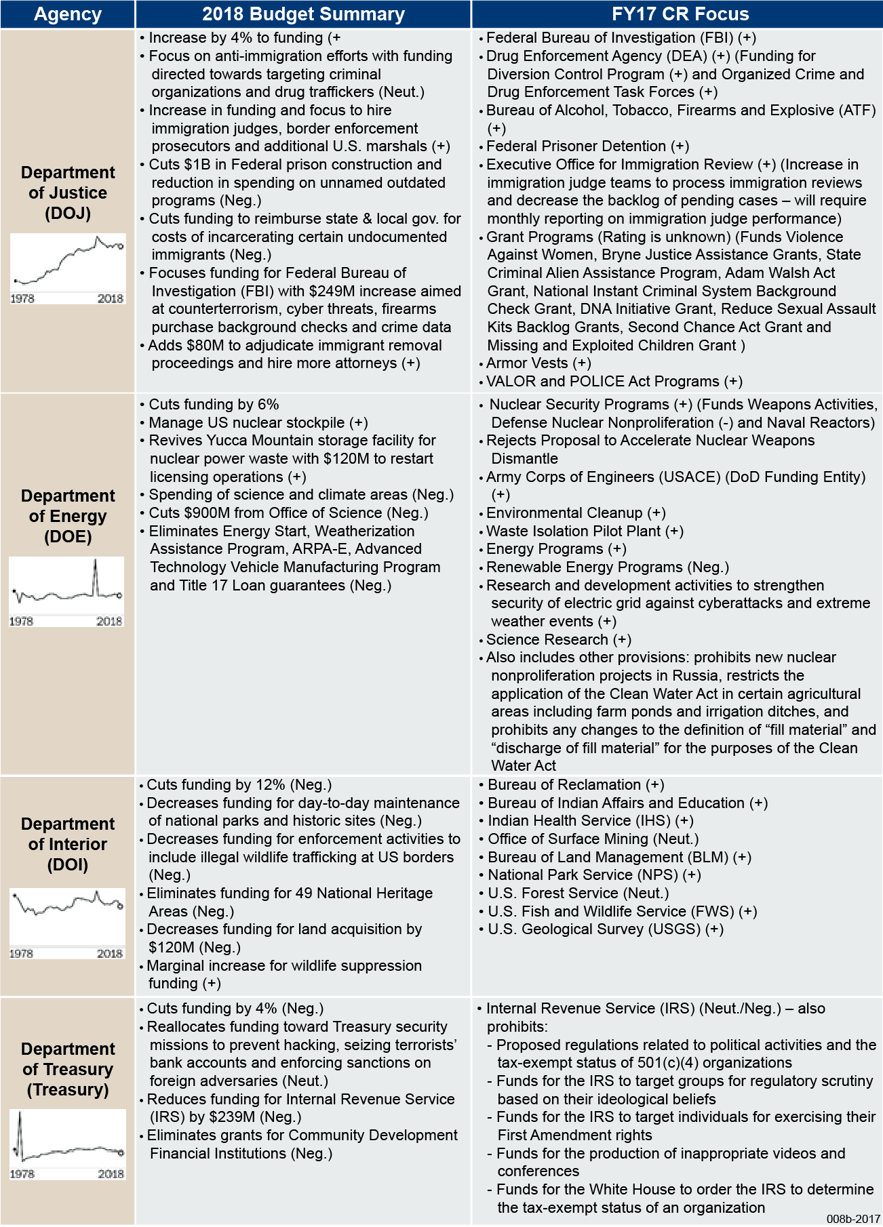
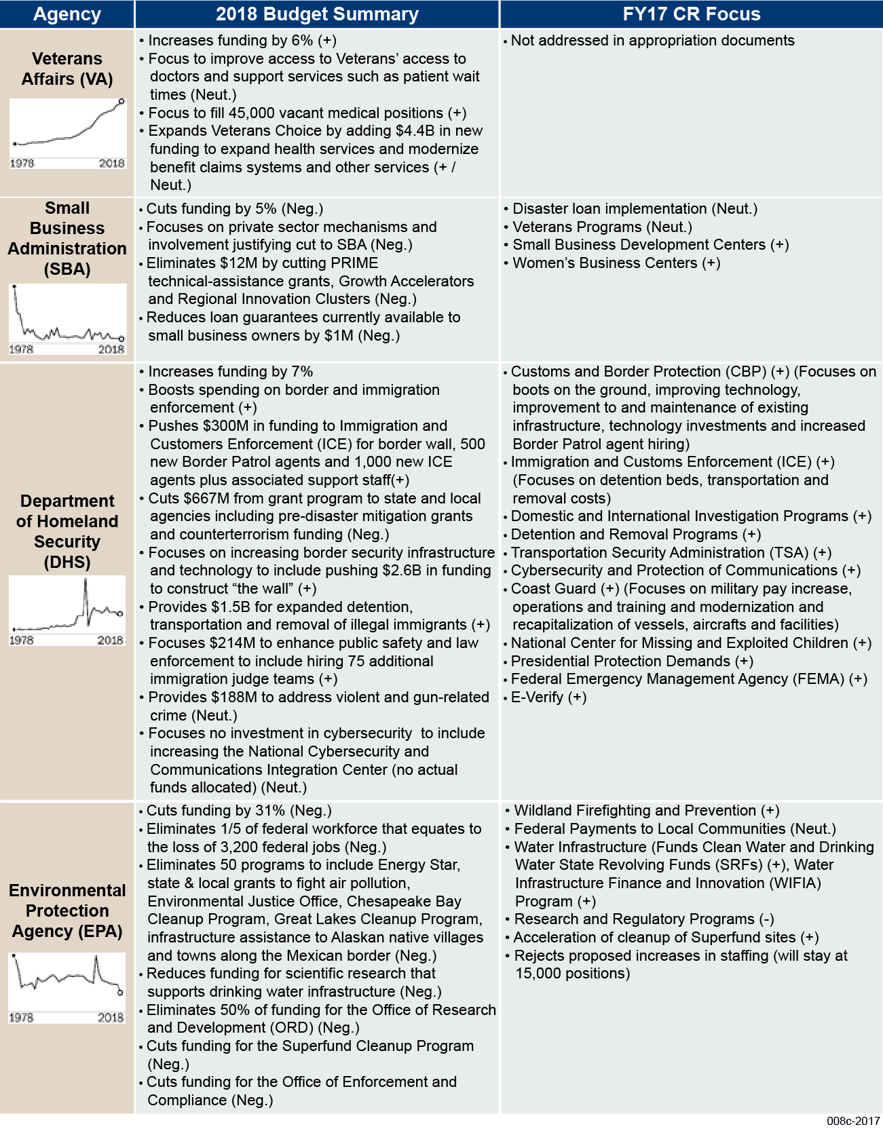
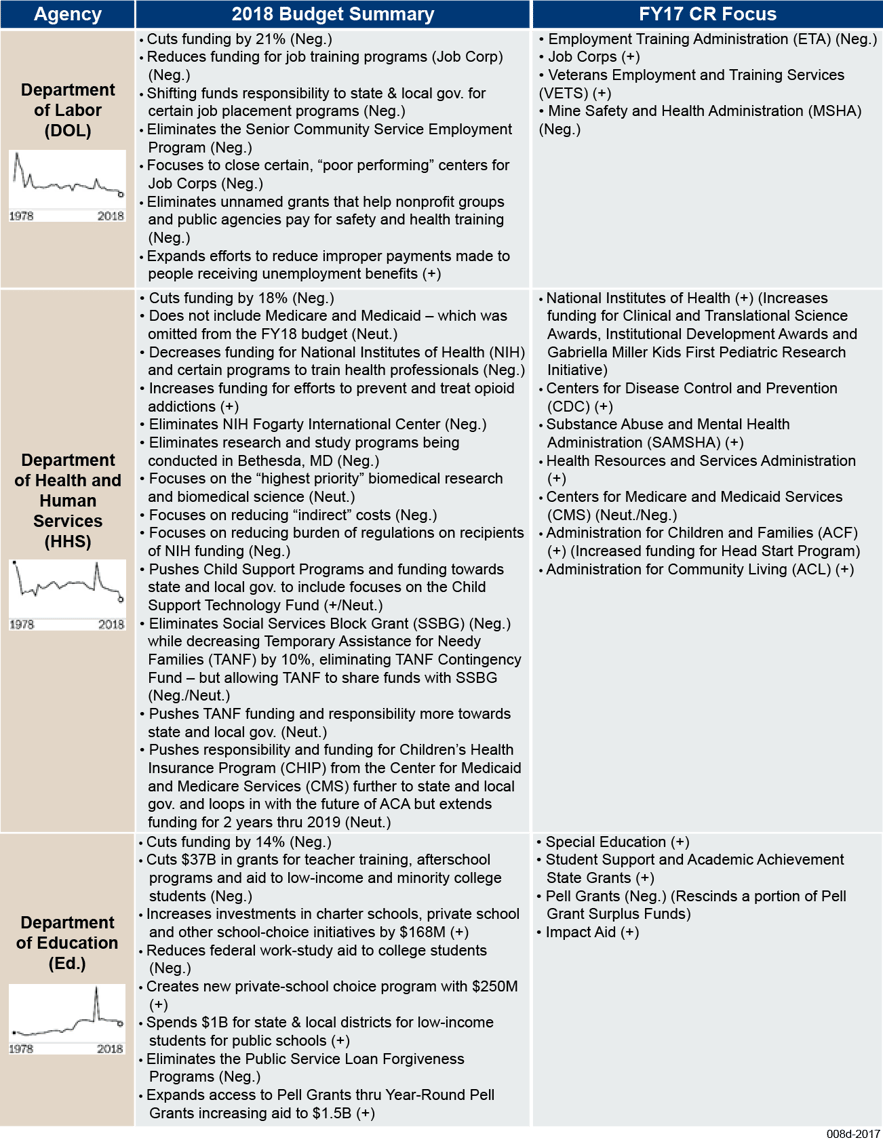
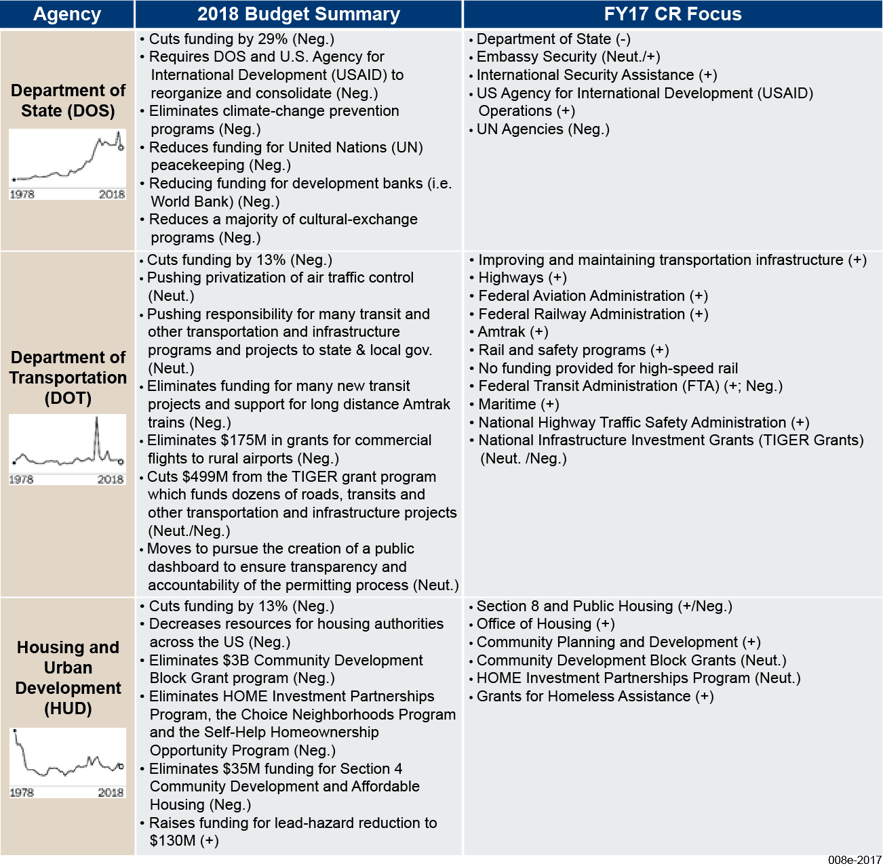
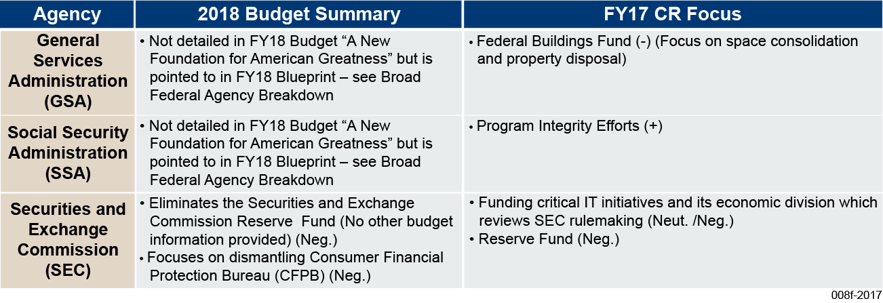
[1] One of the ways President Trump’s budget claims to balance the budget over a decade, without cutting defense or retirement spending, is to assume a $2 trillion increase in revenue through economic growth. This is the magic of the still-to-be-designed Trump tax cuts. However, wait — if you recall, the magic of the Trump tax cuts is also supposed to pay for the Trump tax cuts. Therefore, the $2 trillion is a double-counting error. When Treasury Secretary Steve Mnuchin was asked about this at the Fiscal Summit, he said this was a “preliminary document [referring to FY18 “Foundation” Budget] that would be refined,” as reported by David Wessel of the NY Times.



